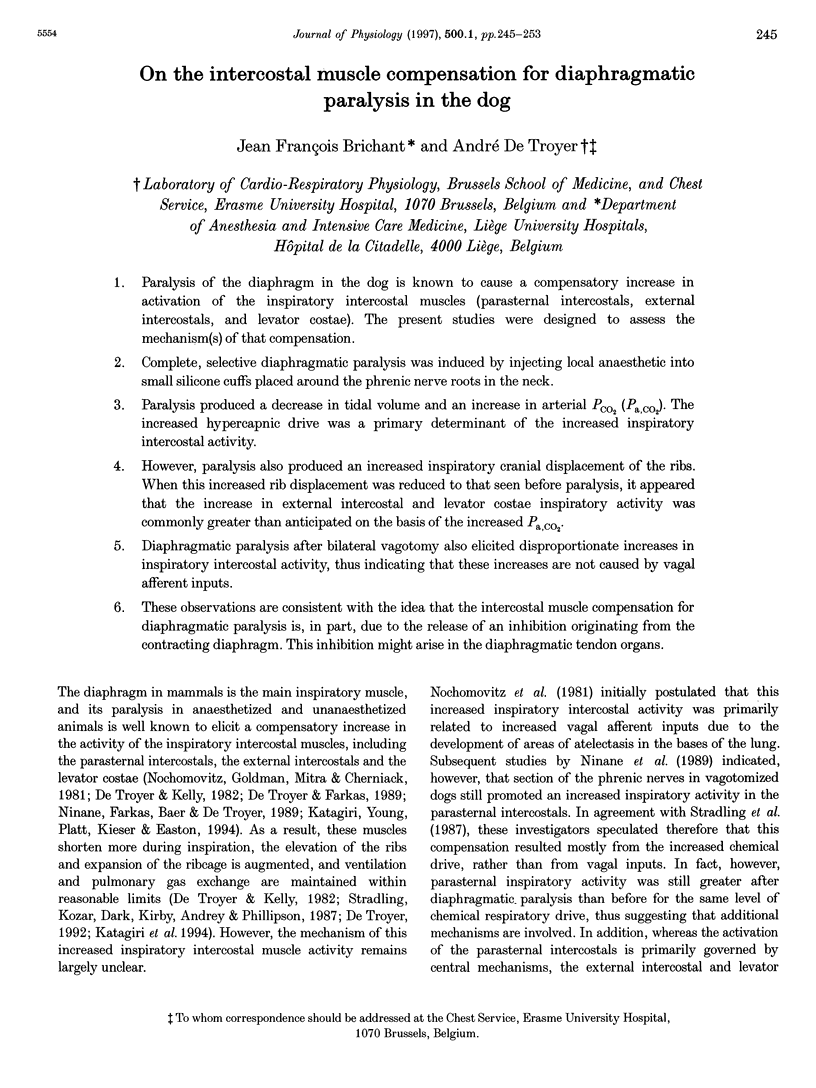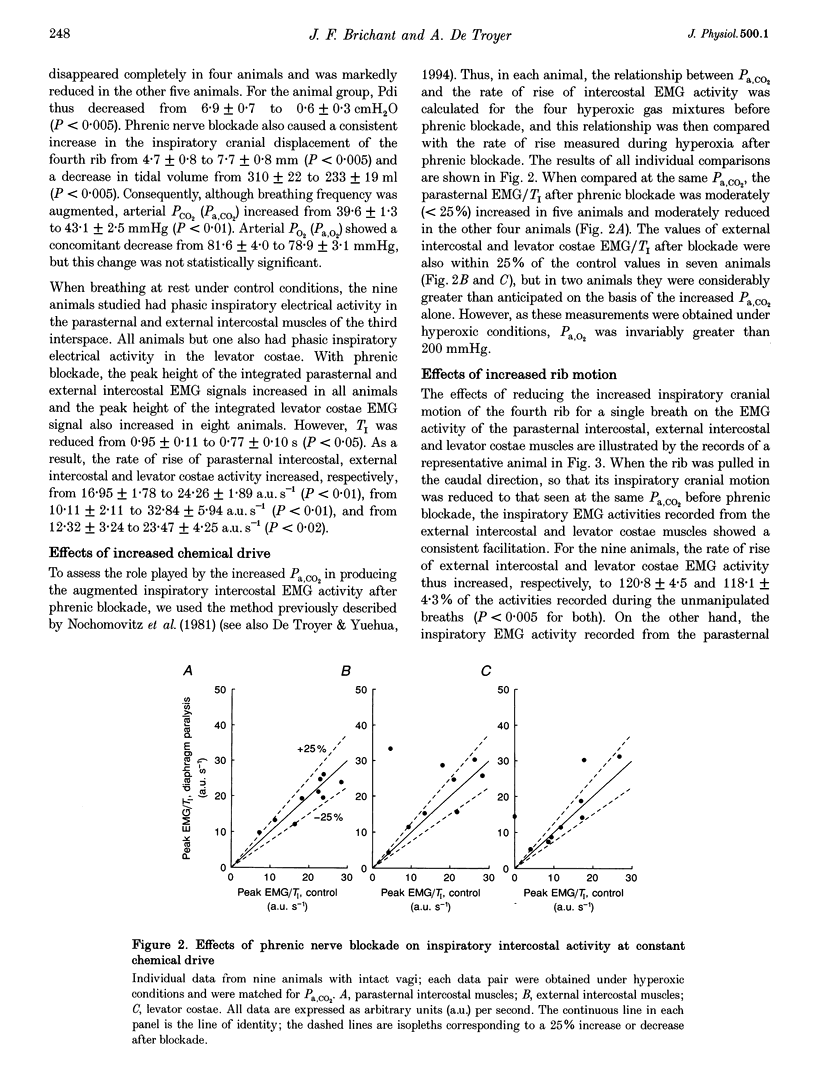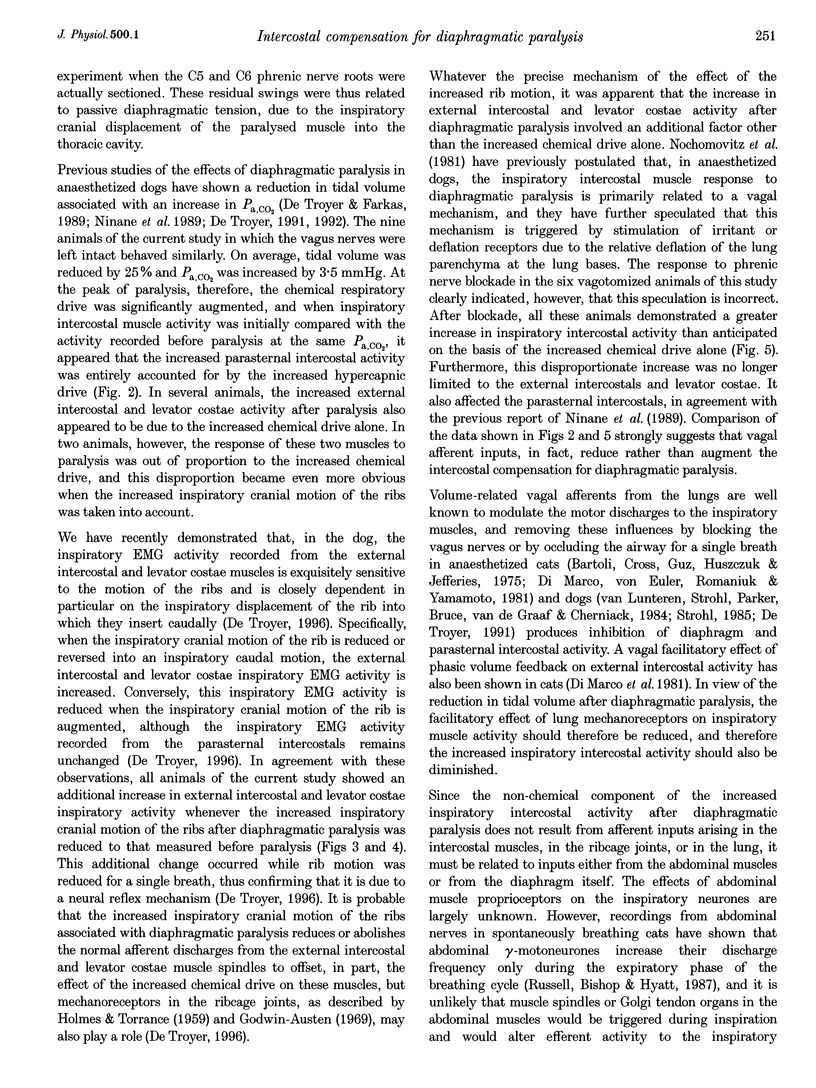Abstract
1. Paralysis of the diaphragm in the dog is known to cause a compensatory increase in activation of the inspiratory intercostal muscles (parasternal intercostals, external intercostals, and levator costae). The present studies were designed to assess the mechanism(s) of that compensation. 2. Complete, selective diaphragmatic paralysis was induced by injecting local anaesthetic into small silicone cuffs placed around the phrenic nerve roots in the neck. 3. Paralysis produced a decrease in tidal volume and an increase in arterial P(CO2) (P(a,CO2)). The increased hypercapnic drive was a primary determinant of the increased inspiratory intercostal activity. 4. However, paralysis also produced an increased inspiratory cranial displacement of the ribs. When this increased rib displacement was reduced to that seen before paralysis, it appeared that the increase in external intercostal and levator costae inspiratory activity was commonly greater than anticipated on the basis of the increased P(a,CO2). 5. Diaphragmatic paralysis after bilateral vagotomy also elicited disproportionate increases in inspiratory intercostal activity, thus indicating that these increases are not caused by vagal afferent inputs. 6. These observations are consistent with the idea that the intercostal muscle compensation for diaphragmatic paralysis is, in part, due to the release of an inhibition originating from the contracting diaphragm. This inhibition might arise in the diaphragmatic tendon organs.
Full text
PDF








Selected References
These references are in PubMed. This may not be the complete list of references from this article.
- Bartoli A., Cross B. A., Guz A., Huszczuk A., Jeffries R. The effect of varying tidal volume on the associated phrenic motoneurone output:studies of vagal and chemical feedback. Respir Physiol. 1975 Nov;25(2):135–155. doi: 10.1016/0034-5687(75)90093-6. [DOI] [PubMed] [Google Scholar]
- Bałkowiec A., Kukuła K., Szulczyk P. Functional classification of afferent phrenic nerve fibres and diaphragmatic receptors in cats. J Physiol. 1995 Mar 15;483(Pt 3):759–768. doi: 10.1113/jphysiol.1995.sp020620. [DOI] [PMC free article] [PubMed] [Google Scholar]
- CORDA M., VONEULER C., LENNERSTRAND G. PROPRIOCEPTIVE INNERVATION OF THE DIAPHRAGM. J Physiol. 1965 May;178:161–177. doi: 10.1113/jphysiol.1965.sp007621. [DOI] [PMC free article] [PubMed] [Google Scholar]
- De Troyer A., Farkas G. A. Inspiratory function of the levator costae and external intercostal muscles in the dog. J Appl Physiol (1985) 1989 Dec;67(6):2614–2621. doi: 10.1152/jappl.1989.67.6.2614. [DOI] [PubMed] [Google Scholar]
- De Troyer A., Kelly S. Chest wall mechanics in dogs with acute diaphragm paralysis. J Appl Physiol Respir Environ Exerc Physiol. 1982 Aug;53(2):373–379. doi: 10.1152/jappl.1982.53.2.373. [DOI] [PubMed] [Google Scholar]
- De Troyer A. Rib motion modulates inspiratory intercostal activity in dogs. J Physiol. 1996 Apr 1;492(Pt 1):265–275. doi: 10.1113/jphysiol.1996.sp021307. [DOI] [PMC free article] [PubMed] [Google Scholar]
- De Troyer A., Sampson M., Sigrist S., Macklem P. T. Action of costal and crural parts of the diaphragm on the rib cage in dog. J Appl Physiol Respir Environ Exerc Physiol. 1982 Jul;53(1):30–39. doi: 10.1152/jappl.1982.53.1.30. [DOI] [PubMed] [Google Scholar]
- De Troyer A. The electro-mechanical response of canine inspiratory intercostal muscles to increased resistance: the cranial rib-cage. J Physiol. 1992;451:445–461. doi: 10.1113/jphysiol.1992.sp019172. [DOI] [PMC free article] [PubMed] [Google Scholar]
- De Troyer A., Yuehua C. Intercostal muscle compensation for parasternal paralysis in the dog: central and proprioceptive mechanisms. J Physiol. 1994 Aug 15;479(Pt 1):149–157. doi: 10.1113/jphysiol.1994.sp020284. [DOI] [PMC free article] [PubMed] [Google Scholar]
- DiMarco A. F., von Euler C., Romaniuk J. R., Yamamoto Y. Positive feedback facilitation of external intercostal and phrenic inspiratory activity by pulmonary stretch receptors. Acta Physiol Scand. 1981;113(3):375–386. doi: 10.1111/j.1748-1716.1981.tb06910.x. [DOI] [PubMed] [Google Scholar]
- Duron B., Jung-Caillol M. C., Marlot D. Myelinated nerve fiber supply and muscle spindles in the respiratory muscles of cat: quantitative study. Anat Embryol (Berl) 1978 Feb 20;152(2):171–192. doi: 10.1007/BF00315923. [DOI] [PubMed] [Google Scholar]
- Easton P. A., Fitting J. W., Arnoux R., Guerraty A., Grassino A. E. Recovery of diaphragm function after laparotomy and chronic sonomicrometer implantation. J Appl Physiol (1985) 1989 Feb;66(2):613–621. doi: 10.1152/jappl.1989.66.2.613. [DOI] [PubMed] [Google Scholar]
- Ford G. T., Whitelaw W. A., Rosenal T. W., Cruse P. J., Guenter C. A. Diaphragm function after upper abdominal surgery in humans. Am Rev Respir Dis. 1983 Apr;127(4):431–436. doi: 10.1164/arrd.1983.127.4.431. [DOI] [PubMed] [Google Scholar]
- Godwin-Austen R. B. The mechanoreceptors of the costo-vertebral joints. J Physiol. 1969 Jun;202(3):737–753. doi: 10.1113/jphysiol.1969.sp008838. [DOI] [PMC free article] [PubMed] [Google Scholar]
- Jammes Y., Buchler B., Delpierre S., Rasidakis A., Grimaud C., Roussos C. Phrenic afferents and their role in inspiratory control. J Appl Physiol (1985) 1986 Mar;60(3):854–860. doi: 10.1152/jappl.1986.60.3.854. [DOI] [PubMed] [Google Scholar]
- Katagiri M., Young R. N., Platt R. S., Kieser T. M., Easton P. A. Respiratory muscle compensation for unilateral or bilateral hemidiaphragm paralysis in awake canines. J Appl Physiol (1985) 1994 Oct;77(4):1972–1982. doi: 10.1152/jappl.1994.77.4.1972. [DOI] [PubMed] [Google Scholar]
- McCloskey D. I., Mitchell J. H. Reflex cardiovascular and respiratory responses originating in exercising muscle. J Physiol. 1972 Jul;224(1):173–186. doi: 10.1113/jphysiol.1972.sp009887. [DOI] [PMC free article] [PubMed] [Google Scholar]
- Ninane V., Farkas G. A., Baer R., de Troyer A. Mechanism of rib cage inspiratory muscle recruitment in diaphragmatic paralysis. Am Rev Respir Dis. 1989 Jan;139(1):146–149. doi: 10.1164/ajrccm/139.1.146. [DOI] [PubMed] [Google Scholar]
- Nochomovitz M. L., Goldman M., Mitra J., Cherniack N. S. Respiratory responses in reversible diaphragm paralysis. J Appl Physiol Respir Environ Exerc Physiol. 1981 Nov;51(5):1150–1156. doi: 10.1152/jappl.1981.51.5.1150. [DOI] [PubMed] [Google Scholar]
- Oliven A., Haxhiu M. A., Kelsen S. G. Distribution of motor activity to expiratory muscles during sciatic nerve stimulation in the dog. Respir Physiol. 1990 Aug;81(2):165–175. doi: 10.1016/0034-5687(90)90043-x. [DOI] [PubMed] [Google Scholar]
- Road J. D., Burgess K. R., Whitelaw W. A., Ford G. T. Diaphragm function and respiratory response after upper abdominal surgery in dogs. J Appl Physiol Respir Environ Exerc Physiol. 1984 Aug;57(2):576–582. doi: 10.1152/jappl.1984.57.2.576. [DOI] [PubMed] [Google Scholar]
- Russell J. A., Bishop B. P., Hyatt R. E. Discharge of abdominal muscle alpha and gamma motoneurons during expiratory loading in cats. Exp Neurol. 1987 Jul;97(1):179–192. doi: 10.1016/0014-4886(87)90292-5. [DOI] [PubMed] [Google Scholar]
- Speck D. F., Revelette W. R. Attenuation of phrenic motor discharge by phrenic nerve afferents. J Appl Physiol (1985) 1987 Mar;62(3):941–945. doi: 10.1152/jappl.1987.62.3.941. [DOI] [PubMed] [Google Scholar]
- Stradling J. R., Kozar L. F., Dark J., Kirby T., Andrey S. M., Phillipson E. A. Effect of acute diaphragm paralysis on ventilation in awake and sleeping dogs. Am Rev Respir Dis. 1987 Sep;136(3):633–637. doi: 10.1164/ajrccm/136.3.633. [DOI] [PubMed] [Google Scholar]
- Strohl K. P. Respiratory activation of the facial nerve and alar muscles in anaesthetized dogs. J Physiol. 1985 Jun;363:351–362. doi: 10.1113/jphysiol.1985.sp015715. [DOI] [PMC free article] [PubMed] [Google Scholar]
- Teitelbaum J., Borel C. O., Magder S., Traystman R. J., Hussain S. N. Effect of selective diaphragmatic paralysis on the inspiratory motor drive. J Appl Physiol (1985) 1993 May;74(5):2261–2268. doi: 10.1152/jappl.1993.74.5.2261. [DOI] [PubMed] [Google Scholar]
- van Lunteren E., Strohl K. P., Parker D. M., Bruce E. N., Van de Graaff W. B., Cherniack N. S. Phasic volume-related feedback on upper airway muscle activity. J Appl Physiol Respir Environ Exerc Physiol. 1984 Mar;56(3):730–736. doi: 10.1152/jappl.1984.56.3.730. [DOI] [PubMed] [Google Scholar]


